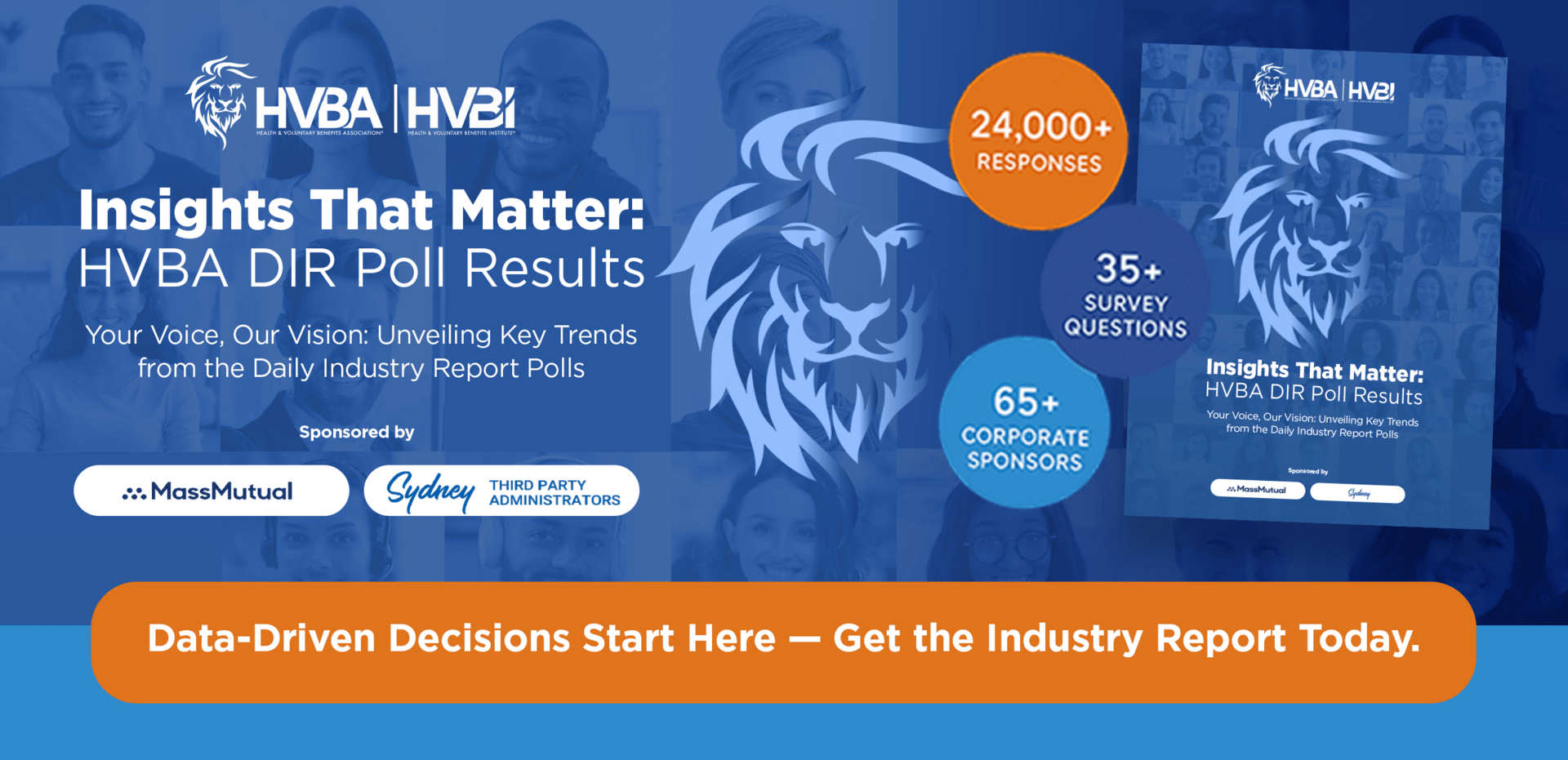- Daily Industry Report
- Posts
- Daily Industry Report - July 25
Daily Industry Report - July 25

Your summary of the Voluntary and Healthcare Industry’s most relevant and breaking news; brought to you by the Health & Voluntary Benefits Association®
Jake Velie, CPT | Robert S. Shestack, CCSS, CVBS, CFF |
Venus Williams Reveals She Returned to Tennis Over Health Insurance
By Jasmine Laws - Venus Williams has claimed that her return to tennis, after 16 months away from the sport, was because she needed the health insurance. "I had to come back for the insurance," she said in an on-court interview following her Mubadala Citi D.C. Open victory against Peyton Stearns in Washington on Tuesday. "They informed me this year that I'm on COBRA, so it's like, I got to get my benefits on," she said, giggling to interviewer Rennae Stubbs, which prompted a chorus of laughter from those watching in the stands. Read Full Article…
HVBA Article Summary
Healthcare Struggles Despite Wealth: Venus Williams revealed she continues competing partly to maintain health insurance, despite her $95 million net worth. Her situation highlights gaps in the U.S. system, where even wealthy individuals may need to rely on continued employment or costly options like COBRA, which allows temporary continuation of employer-provided benefits but often at very high premiums.
Rising Costs Affect Everyone: Williams’ comment echoes findings from a KFF study showing six in ten Americans worry more about paying for medical care and surprise bills than housing, food, or utilities. Her reliance on continued play and potentially expensive COBRA coverage illustrates how healthcare insecurity impacts not only average Americans but also public figures with significant assets.
Coverage Gaps for Middle-Aged Americans: At 45, Williams cannot qualify for Medicare, which is reserved for those 65 and older, and her wealth disqualifies her from Medicaid. For people in her position—too young for federal programs and without a steady employer income—playing professionally or turning to COBRA (with benefits lasting 18 to 36 months) may be among the few options to maintain reliable health insurance despite injuries, surgeries, and other ongoing medical needs.
HVBA Poll Question - Please share your insightsShould A&H carriers provide a 1099 for Accident, Critical Illness, and Hospital Indemnity claims exceeding $600? |
Our last poll results are in!
59.38%
Of Daily Industry Report readers who participated in our last polling question, when asked, “What strategies do you feel are most effective to gain deeper transparency into — and thereby better manage — total pharmacy spend?” responded with “disaggregate PBM management & functions (formularies, clinical, claims, network access & rebates).”
25% feel the most effective strategies are to “leverage robust data & reporting tools that allow you to analyze costs and trends,” while 9.37% believe it to be “partnering with a smaller, more flexible PBM that will allow formulary customization.” The remaining 6.25% feel that “carve-out specialty vs. traditional drugs, especially the biosimilar drugs,” are the most effective strategies to gain deeper transparency into — and therefore better manage — total pharmacy spend.
Have a poll question you’d like to suggest? Let us know!
UnitedHealth complying with DOJ investigation: 5 things to know
By Rylee Wilson - UnitedHealth Group is complying with criminal and civil investigations into its Medicare Advantage business, the company said in a July 24 regulatory filing. The disclosure comes after The Wall Street Journal reported in May that the Justice Department has been investigating allegations of Medicare Advantage fraud. In May, the company said it had not been notified about any investigation by the Justice Department. Read Full Article…
HVBA Article Summary
UnitedHealth Cooperates with DOJ Investigation into Medicare Billing Practices: UnitedHealth voluntarily contacted the Department of Justice after reports of an investigation into its Medicare Advantage billing and coding practices. The company is now responding to formal criminal and civil requests, with the inquiry dating back to at least 2024 and focusing on how patient diagnoses were reported for federal reimbursements.
Scrutiny Over Upcoding Allegations Across the Insurance Industry: UnitedHealth is facing examination over potential upcoding practices, where diagnoses may be exaggerated to increase federal payments. While this issue has surfaced across nearly all major insurers, the company maintains that audits by the Centers for Medicare & Medicaid Services show its billing practices to be among the most accurate in the industry.
UnitedHealth Responds with Oversight and Structural Adjustments: To address concerns and strengthen compliance, UnitedHealth has launched third-party reviews of its coding, risk assessment, managed care, and pharmacy practices. These efforts coincide with other major challenges for the company, including leadership transitions, rising medical costs, a cyberattack on a key subsidiary, and the death of a former CEO in late 2024.
UnitedHealth, Anthem, Cigna unveil what small employers might pay for 2026 health coverage
By Allison Bell - Small employers' premiums for fully insured health plans could jump in some states in 2026 but continue along roughly the same path as in 2025 in other states. A look at the small-group rate proposals filed in six jurisdictions shows that the requested increases vary widely. Here's how the median requested increases for 2026 compare to the original median requested increases for 2025 Read Full Article… (Subscription required)
HVBA Article Summary
Premium Increases for 2026 Outpace 2025 Across Most States and Markets: Health insurers’ median requested premium hikes for 2026 are significantly higher than last year in many states, including Rhode Island (20.8% vs. 10.6%) and the District of Columbia (9.9% vs. 5.6%). While some states, like Minnesota and Oregon, are seeing modest decreases, analysts note the typical proposed individual market increase is around 15% for 2026 — more than double the typical 7% requested for 2025 and the largest jump since 2018.
Rising Medical Costs and Policy Uncertainty Drive Rate Proposals: Insurers cite medical inflation, potential federal tariffs, and changes to Medicaid funding and Affordable Care Act premium tax credits as major factors influencing rates. With uncertainty over the health status of enrollees, regulators have granted insurers additional time to finalize rates, which remain subject to review, rejection, or adjustment before approval.
Shrinking Small-Group Market Faces Mounting Cost Pressures: Enrollment in fully insured small-group health plans has declined sharply, falling 39% from 2011 to 11.5 million by 2021. Costs continue to climb, with average premiums up 6.1% in 2024 and PwC projecting an 8.5% medical cost trend for 2026 in self-insured plans, signaling continued financial strain for employers and insurers alike.
Employees would take a job if Ozempic was part of their benefits package
By Alyssa Place - The demand for popular weight loss drugs isn't slowing down anytime soon — and offering them in your benefits package could play a key role in recruiting younger generations of employees. According to data from KFF, over 12% of Americans have tried these medications and nearly 40% using them solely for weight loss. But as access remains limited — often by cost or insurance coverage — companies are now evaluating how, or whether, to include these drugs in their benefits packages. Read Full Article… (Subscription required)
HVBA Article Summary
GLP-1 Medications Are Reshaping Weight Loss Trends and Workplace Benefits: Drugs like Ozempic are gaining popularity, especially among millennials and Gen Z, with nearly one-third preferring GLP-1s as their weight loss method and many seeing employer-provided access as a job perk. While 7% of Americans currently use these medications, widespread adoption is tempered by concerns over dependency, weight regain, and high costs, making sustainable solutions a parallel priority.
Employers Explore GLP-1 Coverage as a Competitive Advantage Amid Divided Opinions: Companies are considering adding GLP-1 medications to health benefits or HSAs/FSAs to attract and retain talent, with 39% of millennials and 35% of Gen Z saying access would boost their job satisfaction. However, only 14% of Americans support universal insurance coverage, with most preferring coverage only for those with medical conditions, highlighting tensions over cost, fairness, and long-term outcomes.
Sustainable Wellness Programs Provide Alternatives and Complements to GLP-1s: Employers can foster lasting weight management by offering initiatives like nutrition stipends, on-site or virtual fitness classes, mental health and weight loss coaching, and incentive-based wellness programs. These holistic approaches help employees build healthier habits, improve well-being and productivity, and reduce reliance on costly medications.
Long-term care insurance still a rare benefit for employees, and enrollment is low
By Kathleen Steele Gaivin - Approximately 24% of respondents to a recent survey who are eligible for benefits where they work said they had access to long-term care insurance there, and 9% of those employees said they had enrolled in that insurance. For the Employee Long-Term Care Survey, fielded late last year by the Employee Benefit Research Institute, the institute questioned 2,445 workers aged 20 to 74 regarding their awareness of, access to and perspectives on long-term care financing. Read Full Article…
HVBA Article Summary
Awareness and Preparedness Gaps: Although 40% of survey respondents expect to need some form of long-term care for themselves in the future, only 23% report knowing how to access such care. Familiarity with care systems is significantly higher among individuals with direct experience, such as those who have filed disability claims or received care, highlighting a broad knowledge gap for the majority of workers who may face future care needs.
Significant Personal and Financial Impacts: About three-quarters of those surveyed expect to provide care for an adult family member, such as a spouse, parent, or in-law, with 45% anticipating direct caregiving and 40% expecting to provide both financial and physical support. Many predict care needs could last multiple years, with 30% anticipating durations over two years and 20% expecting five or more years. Combined with long-term care costs averaging $131,000 annually for baby boomers — far exceeding the $50,000 many anticipate — these demands create substantial risks to individuals’ finances and their ability to stay productive in the workforce.
Employer and Policy Responses: State programs like Washington’s 2021 WA Cares Fund, which provides publicly funded long-term care benefits, have spurred a surge in employer interest in offering private long-term care insurance. Employers can often secure more favorable pricing and underwriting, while also educating workers about available benefits. Companies like Amazon are now exploring ways to simplify communication, allow earlier benefit access, and expand offerings to include family caregiving support, reflecting a growing corporate role in addressing employees’ long-term care challenges.
Mercer: Half of large employers plan to shift health plan costs onto employees
By Carolyn Crist - As health plan costs continue to increase, more employers intend to change or reduce their 2026 benefit offerings to control spending, according to July 16 survey results from Mercer. For instance, 51% of large employers (defined as those with 500 or more employees) said they’re likely — or very likely — to make plan changes that would shift more costs to employees, such as raising deductibles or out-of-pocket maximums. The percentage increased from 45% in 2024. Read Full Article… (Subscription required)
HVBA Article Summary
Employers Brace for Rising Healthcare Costs and Strategic Benefit Shifts: U.S. employers expect health benefit costs to increase by nearly 6% in 2025, with 2026 projected to bring even greater financial strain. To manage these pressures, companies are balancing short-term cost controls with long-term strategies, such as narrow network plans, designed to deliver high-quality, cost-effective care for employees.
Plan Redesign and Drug Costs Drive Employer Decisions: Large employers are increasingly considering non-traditional plan designs, including variable copay options, with 35% planning to offer them by 2026. At the same time, rising costs of GLP-1 drugs for diabetes and obesity treatment — averaging around $1,000 per patient per month — are forcing some employers to weigh cutting coverage despite potential long-term health benefits.
Mental Health and Voluntary Benefits Emerge as Workforce Priorities: While navigating rising costs, employers continue to invest in employee well-being. More than 75% of large employers plan to offer digital stress management and resiliency resources in 2026, and by 2027, nearly one-third expect to expand voluntary benefits, such as pet insurance and employee perks, to boost satisfaction, retention, and productivity.

8 Ways to Sustain Employee Benefits Engagement Year-Round
By Kathryn Mayer - It’s an age-old story: Benefits are extremely valuable to employees, helping them cover medical expenses, save for retirement, navigate caregiving responsibilities, take time away from work, and more. But often, they’re extremely confusing to employees, and even at times a little dull. Read Full Article… (Subscription required)
HVBA Article Summary
Employers Struggle to Communicate Benefits Effectively: Many employees find workplace benefits confusing due to complex terminology and limited communication, which typically occurs only during open enrollment. This lack of clarity results in employees often misunderstanding or underutilizing the benefits available to them, despite their potential value in improving satisfaction and retention.
Year-Round, Multi-Channel Communication Improves Engagement: Employers can boost understanding and participation by creating a year-round communication strategy that uses diverse methods such as surveys, scheduled messaging, face-to-face meetings, emails, text campaigns, and digital tools. Reaching employees consistently and through their preferred channels ensures benefits remain top-of-mind and accessible.
Evaluating and Aligning Benefits with Employee Needs Strengthens Retention and Well-Being: Regularly reviewing benefit usage and employee feedback helps organizations refine offerings, ensuring they stay relevant and supportive of diverse needs. Consistent messaging across locations and a focus on health, financial security, and life planning help employees feel valued and supported by their employer.







